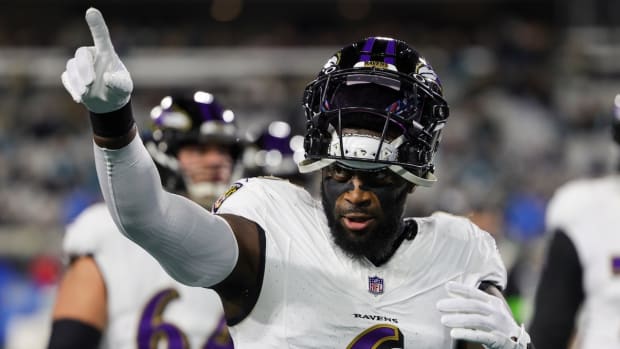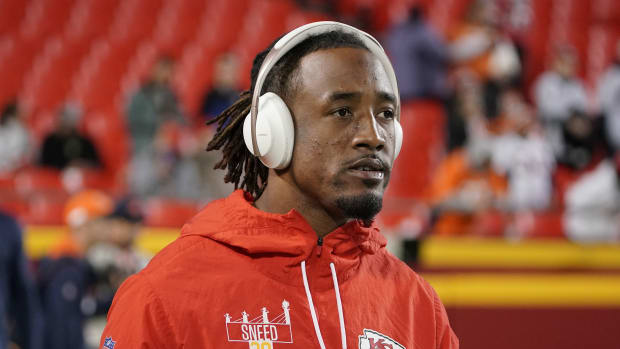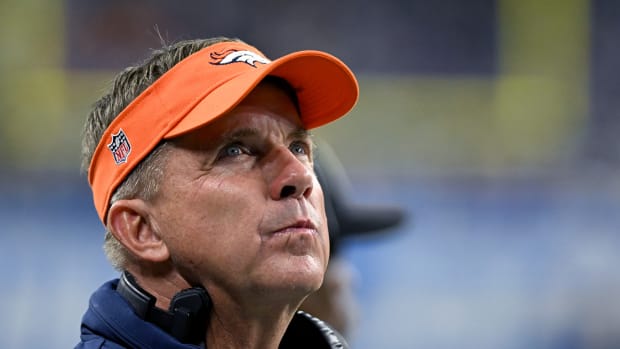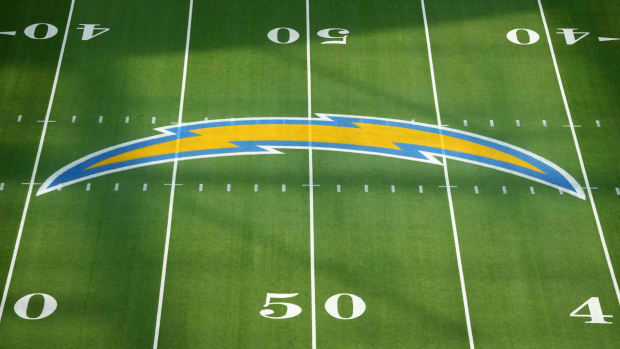SI 64: Nos. 29-25: Eric Kendricks, Maxx Williams, T.J. Clemmings, more
With the 2015 NFL draft fast approaching, it’s time for all 32 NFL teams to start getting their draft boards in order and ranking players based on their own preferences. At SI, it’s time for us to do that as well. To that end, Doug Farrar and Chris Burke have assembled their own definitive Big Board, consisting of the players they feel deserve to be selected in the first two rounds.
• The SI 64 (so far): Counting down top prospects in the 2015 NFL draft
As we begin to make the turn for home, the next five prospects could all be selected in Round 1 of this year's draft. The two linebackers spotlighted below might be 100-tackle players in the NFL before long. They're joined in this group by a potential game-breaking tight end, an emerging offensive tackle and a defensive lineman capable of taking over games up front.
• The MMQB's NFL draft roundtable: Latest rumors, theories and predictions
Prospects Nos. 29-25 on our SI 64:
29. Eric Kendricks, LB, UCLA
Bio: Kendricks wrapped his UCLA career with 481 tackles, the program’s all-time leader in the category, and led the nation in solo tackles last season with 101. He started 42 games for the Bruins from 2011-14, earning second-team All-America honors in his senior season. If the tackles were not enough, Kendricks also picked off five passes and scored three defensive touchdowns as a Bruin. His brother Mychal played at Cal and is a member of the Philadelphia Eagles. His dad Marv was a running back for the Bruins back in the 1970s and went on to play in the CFL.
Strengths: Perhaps it’s in his blood—Kendricks displays phenomenal instincts, especially against the run. Almost never caught out of position; on the contrary, usually among the first defenders to diagnose a play and begin flying to the football. Prototypical sideline-to-sideline range, with enough speed (4.61-second 40 at the combine) to outrun moving blockers so he can close on a runner. An absolute menace on screen plays, too, both in locating backs coming out as receivers and in getting wide when a receiver’s the target. Arguably the best coverage linebacker available in the 2015 class. Kendricks is smooth dropping, stays right with his assigned receiver in man-to-man coverage and limits gains if he allows a catch. Disciplined in all aspects of his responsibilities, frequently covering up his teammates' mistakes.
[daily_cut.nfl draft]Weaknesses: His size may put a ceiling on his draft stock, even as quick but undersized linebackers continue to make hay in the NFL. There will be teams that worry about Kendricks getting through a 16-game season given his build and the velocity with which he plays. Can he drive back a ballcarrier upon impact? Can he fend off blocks from NFL fullbacks or tight ends to get through traffic? His college production hints that he can, but we’ll have to see. Despite having racked up 10.0 sacks at UCLA (4.0 as a senior), odds are Kendricks will not find a lot of success as a blitzer. (Because of his play in coverage, he may not be used in that fashion much anyway.) Actually does miss tackles from time to time when he tries to take on runners high.
Conclusion: Shaq Thompson could have something to say about it, but do not be surprised if Kendricks is the first off-ball linebacker to hear his name called in Round 1. His ability to sniff out a run play appears to be unmatched at his position this year, and it will give Kendricks every opportunity to start immediately. As a bonus, he also does not have to come off the field on passing downs—Kendricks is rangier than his timed speed, with those run-defense instincts translating over to coverage. His size and strength are knocks, yet minimal ones. Overall, Kendricks is an extremely impressive prospect.
Pro comparison:Sean Lee, Cowboys (Round 2, 2010)
—CB
28. Benardrick McKinney, LB, Mississippi State
Bio: A second-team AP All-America and Sports Illustrated first-teamer, McKinney made 71 tackles (eight for loss) in his final season with the Bulldogs. Over his three-year collegiate career, McKinney recorded 244 tackles, 19.5 tackles for loss and 7.5 sacks. He was first-team All-SEC in 2014, as well as a semifinalist for the Bednarik, Butkus and Lombardi Awards. McKinney redshirted as a true freshman in '11. He played quarterback in addition to linebacker in high school, accounting for 22 touchdowns and 2,000-plus yards of offense during his senior season.
Audibles Podcast: Behind the scenes of this year's SI 64
Strengths: Imposing presence at linebacker. Looks every bit of his 246-pound weight but still moves well. Tough to deal with when he's coming downhill because he throws his power behind any collisions with offensive linemen. Will create contact and bounce off, then find the football. A valuable blitzer from the inside with enough foot speed to provide a similar presence off the edge. Diagnoses plays well, keeping himself out of traffic until he can find a seam. Rarely misses a tackle. Doesn't cede much ground after getting to the ballcarrier, either—wraps up and drives back toward the line of scrimmage. Has size and mobility to deal with tight ends between the hash marks. Nothing flashy here, just steady and reliable production.
Weaknesses: Sluggish when asked to go sideline to sideline and can be taken advantage of by teams able to match him against shifty tight ends or running backs in space. Won't make a lot of plays chasing from behind if his initial read-and-react movement fails to result in a tackle. Only so-so footwork, which means that he can get himself in trouble on misdirection plays. The real curiosity is why McKinney isn't more of a devastating finisher. Between his size, intelligence and desire to get downhill, it seems like he should lower the boom on a ballcarrier or quarterback more often.
Conclusion: McKinney is versatile in his own right, albeit in a slightly different way than Kendricks. Both guys can get downhill to stuff a run, but McKinney's value against the pass may be as a blitzer. While his length helps McKinney defend passes, he does not feature the lateral quickness of Kendricks, so he may open as a two-down linebacker. But he could dominate in those two downs, even more if the linemen in front of him can occupy a blocker or two. McKinney is the last defender fullbacks or tight ends want to see sprinting toward them in one-on-one situations—even if he's stopped, he leaves his mark. His game won't be for every team, but McKinney can be a productive NFL linebacker for the next several years.
Pro comparison:Brandon Spikes, free agent (Round 2, 2010)
—CB
27. Maxx Williams, TE, Minnesota
Bio: Williams redshirted as a freshman in 2012 and then played just two seasons before turning pro, so teams will be intrigued by his potential. His 36 catches and 569 yards receiving (remarkably) led Minnesota last season, as did his eight touchdown receptions. Williams was an all-Big Ten first-teamer last season and averaged 16.2 yards per catch over his career. In 2013 he was just the third sophomore ever named a finalist for the Mackey Award, presented to the nation's top tight end. His dad, Brian Williams, played 11 seasons with the New York Giants.
• VRENTAS: FSU's star TE steps out of grandfather Jack Nicklaus's shadow
Strengths: Freakishly athletic for the tight end position, which will make him appealing to any team seeking a field-stretching option there. Quickly moves into space on short and intermediate routes, then accelerates to the second level and beyond. Difficult to bring down in the open field—he hurdled lunging defenders on multiple occasions during his college career. More than enough speed to challenge the seam. Creates dream mismatches for quarterbacks downfield, with speed to beat linebackers and pressure safeties plus a wide catch radius. Outstanding body control and hands, too, so quarterbacks can throw him open. At the very least, should be a red zone staple as a rookie. Sky could be the limit if a team unlocks the rest of his potential.
Weaknesses:Eric Ebron learned last year that it takes more than natural gifts to be a successful NFL tight end. Williams must be careful not to suffer the same pratfalls and can start by honing his route-running. Excelled on contested catches, but was he in so many of those situations because he could not clear more space? Right now, he cannot be counted on as an in-line blocker—ideal team fit would be one with a mauler already in place so he can play the move role in two- or three-tight-end sets. Subpar blocking goes hand-in-hand, to some degree, with a need to add some strength.
2015 NFL draft positional rankings: Wide receiver
Conclusion: As is the case with, say, Jameis Winston and Marcus Mariota at quarterback or Landon Collins at safety, Williams ought to benefit from the overall lack of draft depth at his position. He could land in Round 1 in large part because there is not another tight end who warrants such a high selection. However, that's not to say that Williams is an overrated talent. His playmaking skills are electrifying at times, borderline baffling for a prospect of his size. Williams' blocking should improve in time; same for his route-running—remember, his non-redshirt time in school was limited to two years. Should he take those steps forward, rounding out the nooks and crannies of his game to pair with his pass-catching skills, Pro Bowls could be in his future.
Pro comparison:Kyle Rudolph, Vikings (Round 2, 2011)
—CB
[pagebreak]
26. T.J. Clemmings, OT, Pittsburgh
Bio: Clemmings began his career at Pitt in 2010 as a defensive end and started eight games as a true freshman. He was on a decent track until the decision was made to move him to the offensive line before the 2013 season, and his stock has risen precipitously since then. It's easy to see why. With a primarily basketball background (he only played two years of high school football), Clemmings still ranked as the top prep prospect in New Jersey in his senior season. His agility and athleticism, combined with impressive and increasing physical strength, could make him the first offensive lineman taken in the 2015 draft, and as long as the team selecting him understands his developmental curve, Clemmings has All-Pro potential.
• VRENTAS: The making of T.J. Clemmings, the draft's highest-upside tackle
Strengths: Physically imposing player with an ideal frame for his position (6'5", 309) and room for more muscular development. Has the upper-body strength to push defenders back and bury them inside when he gets leverage and keeps his hands inside the jersey. Frequently gets under an opponent's pads, lifts him off his base, and drives him out of the play. Very quick feet in short areas—moves adeptly to face the defender and reset his body. Has the forward speed to be a devastating second-level blocker and envelops linebackers when he hits the target. Once he gets his second foot down and his shoulders squared in any direction, his opponent has very few viable options. Has shown marked improvement at the position in a very short time.
Weaknesses: Kick-step in pass protection is a work in progress. Clemmings will let edge rushers leak to the backside of the pocket when he's too labored and not quick enough in the arc back to the quarterback. Needs to operate out of a two-point stance for ideal pass protection at this point. More of a straight-line blocker at this point—vulnerable to twists and counters. Inexperience was exposed during Senior Bowl week. Needs to be more aware of his surroundings in a general sense. Draft stock could be affected by his right tackle position, though it's easy enough to project him as a left tackle over time.
Deciding where college tackles fit on NFL offensive lines is no simple task
Conclusion: Clemmings is relatively inexperienced, he's only played right tackle, and he's going to need some seasoning before he's ready for the physical rigors and defensive complexity of the NFL. That said, he checks all the raw boxes in a rare way, perhaps better than any other tackle prospect in this class, and with time and in the right system, he may very well be the best tackle out of the group. The Tyron Smith comparison makes sense for a number of reasons. Not only is Clemmings freakishly talented like Smith was at USC, but Smith played right tackle for another reason (the Trojans had Matt Kalil at left tackle) and came into the NFL with limited experience. Smith played right tackle in 2011, his first year with the Cowboys, and then he was ready to dominate on the left side. Clemmings has that level of potential, and he's worth a high pick for a team ready to invest in his development.
Pro comparison: Tyron Smith, Cowboys (Round 1, 2011)
—DF
25. Malcom Brown, DT, Texas
Bio: Brown took a huge leap last season, turning from a solid cog up front to a disruptive force. While starting all 13 games for the Longhorns, Brown led the team in sacks (6.5) and tackles for loss (13). He was the first defensive tackle to lead Texas in tackles (71) since 1984. Among his rewards were a first-team All-America nod and finalist honors for the Outland Trophy and Bronco Nagurski Award.
Strengths: Shoots gaps well up front, especially for a player of his size. Moves well laterally, too, so he can stay involved in run plays and succeed if forced to adjust his initial pass rush angle. Quick reactions off the snap, which Brown complements by getting his hands forward to deliver initial contact. Seems to have a good feel for the game—does not just bull rush without a plan, but rather seeks out the football and chases it. Able to use his power when necessary. Keeps his feet moving, rarely getting bogged down during a play. Capable of playing just about anywhere along the defensive line, including end in a 3-4. Had no problems moving around in Texas's scheme. Stout against the run and should be able to make waves there as a rookie.
Weaknesses: Not as far along as a pass rusher as his numbers indicate. Still needs to work on Plans B and C for penetrating the line because he relies so much right now on his get-off. Counter-moves are lacking. Can be bullied a bit by powerful blockers and coughs up way more ground than is ideal when faced with a double team. Should be better at converting his athleticism to power. A snap count limit may be in order for Brown as a rookie, because he can get worn down.
Conclusion: A 320-pounder with quick feet and scheme versatility? It's no wonder the NFL continues to pay more and more attention to Brown as the draft nears. At this point, it would be rather surprising if he slips out of Round 1. Any team that wants Brown to be a long-term answer at nose tackle or as a one-tech will want to see him more consistently dominate with power up front, but pretty much every other piece is in place for him to get the job done. Brown is a three-down lineman who can disrupt the pocket on a repeated basis.
Pro comparison: Terrance Knighton, Redskins (Round 3, 2009
—CB




































